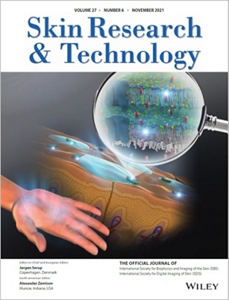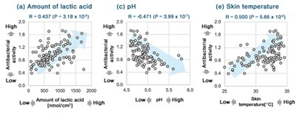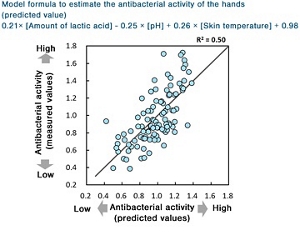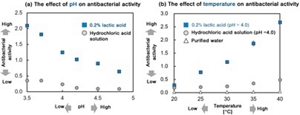The Mechanism of the Innate Antimicrobial Function of the Hands Acts as a Barrier Against Infectious Diseases
The Personal Health Care Product Research Laboratory, Biological Science Research Laboratory, and Analytical Science Research Laboratory of Kao Corporation have found that lactic acid secreted in sweat on the hands, as well as the skin pH and skin temperature of the hands, substantially contributes to the innate surface infection barrier*1 on human hands (hand barrier function). Moreover, they conducted a molecular dynamics (MD)*2 simulation and elucidated the mechanism by which lactic acid effectively acts on bacteria. Kao will use these findings to develop a system that easily predicts hand barrier function and products that improve and maintain it.
These findings were reported in the international journal Skin Research and Technology, and an image of the study findings made the cover of the journal*3 .
-
* 1 A function to reduce bacteria and viruses that cause infectious diseases.
-
* 2 A computer simulation method to predict actual microscopic phenomena by simulating complex molecular motions.
-
* 3 Analysis of hand environment factors contributing to the hand surface infection barrier imparted by lactic acid.
(Skin Res Technol. 2021;27:1135-1144.) https://doi.org/10.1111/srt.13078

Cover of the Journal
Skin Research and Technology
Background
Contact infection occurs when a person touches something contaminated with bacteria or viruses and then touches the mouth, nose, etc.; it is one of the key transmission routes of infectious diseases. Although hand washing and hand disinfection are effective for preventing contact infection, completely preventing infection by constantly washing and disinfecting the hands is difficult because we unconsciously touch our own face with our hands frequently.
Kao's researchers have found that human hands naturally exhibit high antimicrobial ability against various bacteria and viruses and that the effectiveness of this antimicrobial ability varies among individuals. They also revealed that this antimicrobial ability was associated with a person's susceptibility to infection. Therefore, they have focused on the innate hand barrier function that reduces bacteria and viruses on the hands and consequently protects the body from infection.
In a previous study, Kao's researchers demonstrated that lactic acid present on the hands plays an important role in hand barrier function*4 . In further research detailed in the following section, they investigated the conditions under which lactic acid effectively performs its antimicrobial function on the hands.
-
* 4 Kao news release on December 14, 2020, titled "Innate Antimicrobial Function of the Hands Acts as a Barrier Against Infectious Diseases"
https://www.kao.com/global/en/news/rd/2020/20201214-001/
Article: Lactic acid as a major contributor to hand surface infection barrier and its association with morbidity to infectious disease.
(Sci Rep. 2021;11:18608.) https://doi.org/10.1038/s41598-021-98042-4
Association between hand characteristics and hand barrier function
The characteristics of the hands are expected to substantially contribute to hand barrier function because the surface of the hands directly contacts bacteria and viruses. Therefore, from July 27, 2018 to August 28, 2018, the researchers quantitatively evaluated the characteristics of the hands of 106 healthy male and female participants aged 20 to 60 years, to investigate the association between these characteristics and hand barrier function. The measured parameters included a) the amount of lactic acid on the hands, b) fingerprint depth, c) skin pH, d) stratum corneum water content, e) the skin temperature, and f) sweat rate of the hands. The researchers evaluated the participants' hand barrier function by applying Escherichia coli (E. coli) bacteria to their hands and measuring the relative decrease in E. coli 1 minute after the E. coli were applied. The relative decrease was reported as the antibacterial activity. The results of the evaluation showed that hand barrier function was positively correlated with a) the amount of lactic acid and e) the skin temperature and negatively correlated with c) skin pH (Figure 1).

Figure 1. Correlation between hand characteristics (horizontal axis) and hand barrier function (vertical axis, logarithmic values).
In addition, the researchers successfully created a multiple regression model with three factors (i.e., the amount of lactic acid, skin pH, and skin temperature) that enabled them to predict the level of hand barrier function on the basis of these factors (Figure 2). This model enables the level of human hand barrier function to be easily predicted without applying bacteria to the hands.

Figure 2. Prediction of the level of hand barrier function using the model formula.
Verification of the factors contributing to hand barrier function
A model study was performed in test tubes to verify the effects of lactic acid, skin pH, and skin temperature on antibacterial activity. A solution containing E. coli was added to each of the sample solutions, and the mixtures were kept for 30 minutes. The relative decrease in E. coli in each solution was measured and reported as the antibacterial activity. The results of the study showed that, unlike the antibacterial activity in the presence of hydrochloric acid (control), the antibacterial activity significantly increased in the presence of lactic acid under low-pH conditions or high-temperature conditions (Figure 3).

Figure 3. Effects of lactic acid, pH, and temperature on antibacterial activity
Analysis of the mechanism of hand barrier function using molecular dynamics (MD) simulations
In a previous study, the researchers demonstrated that lactic acid inactivated bacteria when it penetrated the bacterial cell membrane and destroyed the inside of bacteria and that this antibacterial activity increased under low-pH conditions. However, the effect of temperature on the antibacterial activity of lactic acid was unclear.
Therefore, the researchers constructed a molecular model of the E. coli cell membrane and calculated physicochemical parameters related to the permeability of a lactic acid molecule into the cell membrane at temperatures between 20 and 40°C using MD simulations (Figure 4). The simulation results suggested that the structure of the E. coli cell membrane loosened and that the permeability of the lactic acid increased at higher temperatures.
Figure 4. Image of the penetration of a lactic acid molecule into the E. coli cell membrane, as modeled using an MD simulation
Conclusion
This research has revealed that lactic acid as well as skin pH and skin temperature of the hands substantially contributes to the innate hand barrier function in humans. Moreover, the MD simulation showed that a higher temperature increases the permeability of lactic acid into the bacterial cell membrane and increases the antibacterial activity of lactic acid.
On the basis of these findings, Kao will develop a system that easily predicts the level of hand barrier function without using bacteria. In addition, the company will also apply these research achievements to the development of technologies and hand hygiene products that enable lactic acid to more effectively act against bacteria on the hands.
The company will further contribute to protecting people worldwide from infectious diseases by offering new hygiene practices that enhance hand barrier function against bacteria and viruses.
About Kao
Kao creates high-value-added products that enrich the lives of consumers around the world. Through its portfolio of over 20 leading brands such as Attack, Bioré, Goldwell, Jergens, John Frieda, Kanebo, Laurier, Merries, and Molton Brown, Kao is part of the everyday lives of people in Asia, Oceania, North America, and Europe. Combined with its chemical division, which contributes to a wide range of industries, Kao generates about 1,400 billion yen in annual sales. Kao employs about 33,000 people worldwide and has 130 years of history in innovation. Please visit the Kao Group website for updated information.
Media inquiries should be directed to:
Corporate Strategy
Kao Corporation
